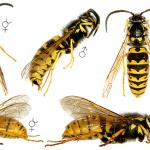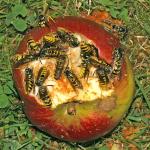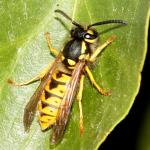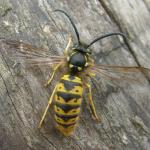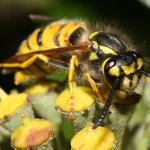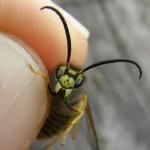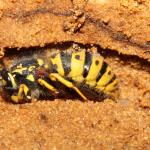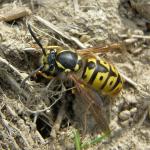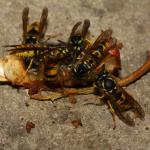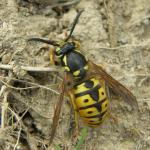Vespa macularis OLIVIER 1792; Vespa maculata SCOPOLI 1763
Vespula germanica and V. vulgaris are our most common social wasps, having a short oculo-malar space (between the bottom of the eye and the base of the mandible). Due to their scavenging habits and choice of nesting sites, they are frequently attracted to homes, gardens and picnic areas, where they may become serious pests. Identification keys and biology are given in Spradbery (1973), Edwards (1980), Else (1994) and Archer (1996).
Widespread in England, Wales, Scotland (recently also including Shetland) and Ireland. Also found on the Isles of Scilly and the Channel Islands.
Overseas, it occurs from about 65°N to north Africa and the Canaries, and eastwards to Sakhalin Island, Korea and China; it is not found in Japan (cf. V. vulgaris). Also found in Canada and the United States south to California. The species has become widely established in the southern hemisphere (Archer 1998, Edwards 1976).
This species is not regarded as being scarce or threatened. However, in common with V. vulgaris, there has been a serious decline in numbers since the late 1970s (Archer 2001).
Found in many types of temperate habitats.
Vespula germanica and V. vulgaris have a much longer life-cycle than species of Dolichovespula. Overwintered queens start searching for nest sites in mid-March. Workers are present from early May to mid-November, and new "autumn" queens leave the nest in September and October. Males are on the wing from mid-August to mid-November (Edwards 1980). A few colonies overwinter, persisting to early spring.
In common with all other social wasps, the workers catch various insects and spiders which are malaxated (chewed up) and fed to the larvae.
Nest sites are mostly underground with entrance tunnels some 3-20cm in length. Open sites are preferred, often in heathland or grassland. Aerial sites are used less commonly than V. vulgaris. The long life-cycle allows nests to grow to a larger size than those of Dolichovespula species; in the soil, nests may reach 25cm in diameter. Nest paper is grey, due to workers collecting well-weathered wood fibres (cf. V. vulgaris).
In spring, queens visit cotoneaster and other early flowering shrubs for nectar. Males and the last workers are often found taking nectar from ivy flowers and the last remaining umbellifer flowers in October and November.
The roundworm Pheromermis pachysoma, the conopid fly Leopoldius cornonatus and the ichneumonid wasp Sphecophaga vesparum are the only parasites of V. germanica known in Britain (Edwards 1980, Smith 1969).
2002


